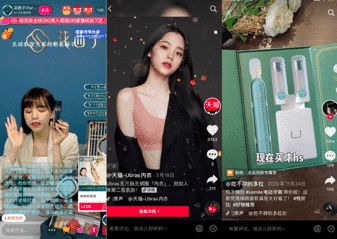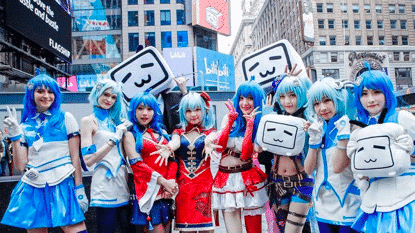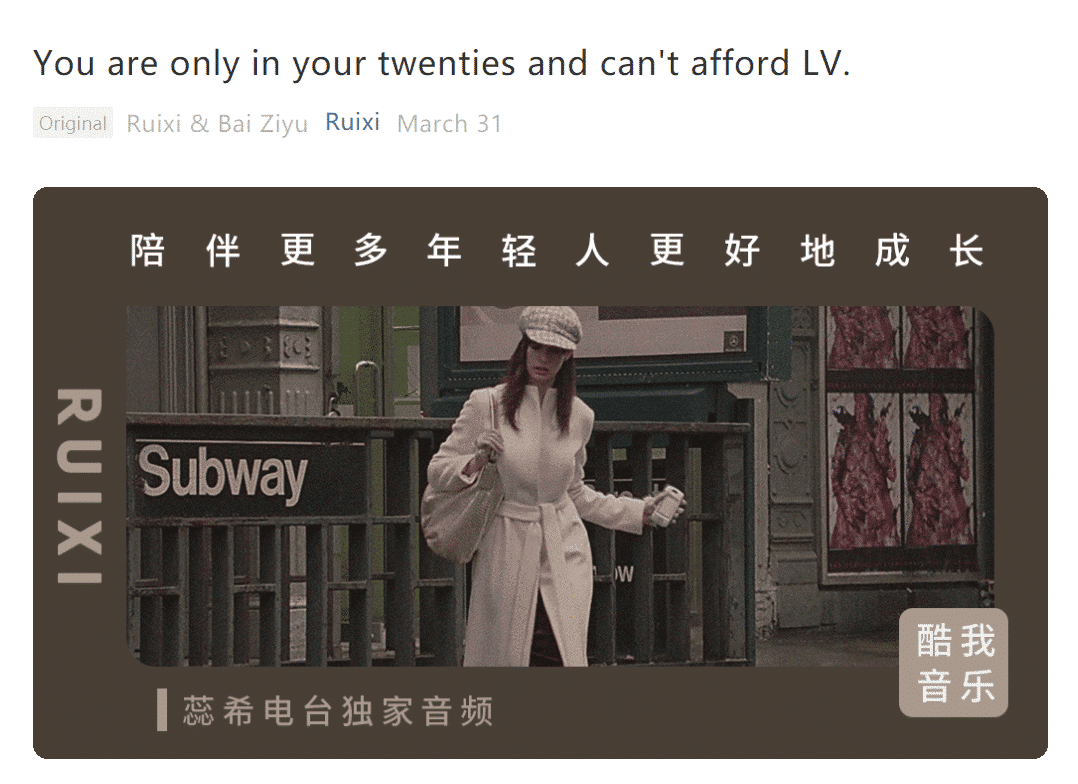With the short video industry very much in the limelight, there have been gains for all kinds of content within many various popular Chinese social media platforms, especially short video apps. Everyone is tipping 2021 to be the year of the short video, but with so many popular Chinese apps to choose from, which platforms are best for e-commerce? Will they find their target audience on Douyin or Kuaishou, Watermelon or Bilibili? And how should brands use the format to market their products? Let’s break down the pros and cons of each of these burgeoning Chinese short video apps.
In this article you’ll learn…
Douyin - China's answer to TikTok
The Chinese social media platform Douyin used to be known as a female-based short video platform, and now half of its users are women and half of them are men. Another recent change is that it used to lean heavily towards young people, but statistics show that 31% of its users are aged between 31 to 40, and users aged between 41 to 50 represent 20%, around the same as the 24 to 30 age group (nearly 20%).
According to Douyin’s 2020 statistic report, its Daily Active User (DAU) rate surpassed 600 million and its Monthly Active User (MAU) rate was over 550 million. The ByteDance-owned short video platform is also the only social media platform that has sponsored the Spring Festival Gala twice.
Music-inspired videos remain the stickiest content on Douyin. Though the content evolved quite a bit in 2020. It’s not uncommon to find videos under five minutes with robust narratives.
In terms of age, post-00s love watching cartoons, post-90s mostly watch news, post-80s watch fashion-related content, and post-70s love watching other people’s weddings.
When it comes to a video’s lifespan, Douyin’s recommendations algorithm facilitates a slow-burn dynamic. The video served up today may, in fact, have been published a long time ago – as long as users’ engage with a piece of content, it will continue to spread further and wider.
Brand opportunities
Douyin is popular with big-name brands such as Adidas, Audi, Michael Kors, and many more.
With the improving quality of Chinese brands and their quick reaction to consumer trends, Chinese brands show up frequently on Douyin as well, such as domestic beauty brand Florasis, underwear brand Ubras, and oral care brand Usmile.

From left to right: Florasis, Ubras, and Usmile
Source: Douyin
In addition to Douyin’s native e-commerce platform, videos can link directly to e-commerce platforms such as Taobao, Jingdong, and more.
The comments section on Douyin is sometimes more interesting than the videos themselves. Brands should not overlook or underestimate the potential marketing power of the comments section, especially the landing page component of the comments section.
When brands are considering whether a KOL is worth having collaboration with, they can check the comments section of the KOL’s sponsored content. If most of the comments are mentioning the product promoted in the post, it is a successful collaboration for both the brand and the KOL. If most of the comments are not related to the product, such as saying hello to the KOL and commenting only on them, then the product is likely not to be noticed or given enough attention in the post.
New features
The launch of the Douyin flagship store. One of the key areas that ByteDance is focusing on is e-commerce, and it wants users to finish the purchasing circle on Douyin instead of going to other e-commerce platforms. Since 2020, those outbound commerce links have been restricted.
Douyin’s flagship store is very similar to Tmall’s flagship store. Heads up, Douyin has an e-commerce feature called Douyin Store (抖音小店). The difference between these two is that Douyin Store requires no threshold to open while flagship stores need a brand’s trademark to apply, which is more trustworthy for consumers.
Other than flagship stores, Douyin is also creating an e-commerce system called “Interest Ecommerce” (兴趣电商). On traditional e-commerce platforms, users search for a specific product or brand. While on Interest Ecommerce, users buy a product because they see someone recommending it and this arouses their interest. The motivation is different. It is estimated that the GMV of Douyin’s Interest Ecommerce will reach over 9.5 trillion RMB by 2023.
Drawbacks
- No matter the size of a KOL, each video is subject to algorithmic-vitality measured by engagement. So even a very popular KOL can produce videos that are duds. User interactions where much of the content is passive, and the platform’s power as a social network is relatively weak. On top of this, the cost of working with KOLs or running official campaigns on Douyin is very high.
- Douyin also relies heavily on the algorithm. At some point, this is good because users can watch videos that they are interested in and it is likely that by presenting those videos to users, they tend to spend more time on Douyin. The downside is that the algorithm filters content that it assumes users might not like. In the long run, users are kept exposing to a certain type of content. If a beauty brand only works with beauty KOLs on Douyin, people who love watching pet videos maybe miss out if the algorithm system doesn’t recommend beauty videos to them.
- Douyin’s flagship store and its Interest Ecommerce are guiding users to finish the purchasing circle on Douyin. At the moment, both are still in the early development stage and there is no winner on the platform yet. It’s a novel and promising area for brands to test the water, and Douyin is giving support especially for fashion brands either they are domestic brands or international luxury brands.
Kuaishou - a rising star within Chinese social media
According to CBNData, in 2020, Kuaishou’s average DAU reach 264 million, which is a 50% growth compared with 2019. The average time that a user spends on the platform grew from 74.6 minutes to 87.3 minutes in 2020. In terms of users’ location, they used to live in lower tier cities but with Kuaishou’s ambition to gain more users in higher tier cities, the majority of them are located in the new second and third tier cities.
Though Douyin’s users have higher consumption ability, Kuaishou’s users are known for their loyalty towards KOLs that they like. Lao Tie (老铁) culture, meaning deeper relationships more than just friends, is a popular term on the platform. Kuaishou’s users are very willing to purchase a product with the recommendation from KOLs that they follow. Based on Kuaishou’s first financial report after it filed an IPO in February 2021, the average repurchase rate of its e-commerce system reached 65% in 2020, which is huge progress compared with 2019’s (45%).
Because Kuaishou KOLs who utilize Chinese social media are primarily made up of communities of authentic consumers and micro-KOLs, as opposed to large-scale KOLs and celebrities, the content has a very strong grassroots, raw feel to it. For instance, a lot of the content features home cooking or playing pranks on friends. However, the platform also has representation in beauty, skincare, games, and education.
Kuaishou’s “Follow” page is the platform’s main content hub. As well as giving Kuaishou a genuinely “live” feel, the “Follow” page helps amplify KOL content, exposing influencer content to more users.
The platform’s users are also sticky, spending a lot of time on the platform. Compared to Douyin users, Kuaishou users are more generally more engaged, willing to not only “like” content from their favorite KOLs, but also to comment, and share.
E-commerce
Kuaishou itself has a strong atmosphere for e-commerce livestream. According to its 2020 E-commerce Report by CBNData, there is an e-commerce livestream every 2 seconds on Kuaishou.
In addition to Kuaishou’s native e-commerce platform, videos can link to platforms like Youzan, Taobao, Kuaishou Xiaodian, and others.

Xinba welcomed back his followers by kneeling on the ground.
Source: screenshot from Kuaishou.
Drawbacks
- As one of the most popular Chinese apps, Kuaishou’s big disadvantage is a comparative lack of higher-quality user-generated content. The quality of content on the platform tends to be relatively low. In terms of commercialization, the platform is still in its infancy, and its ability to monetize content is far weaker than Douyin.
- Another drawback is that Kuaishou is dominated by six big “families”. These families are usually lead by one top KOL and the KOL develops more live streamers to join his/her team. The most well-known one is Xinba. In 2019 Kuaishou’s GMV was 59.6 billion RMB, and Xinba himself achieved 13.3 billion RMB, not to mention the fact that 4 of the TOP10 live streamers were from his team. It is fair to say Xinba’s family took up contributed nearly a quarter of Kuaishou’s GMV.
- In total these six families covered 500 million followers. It is risky for a platform to let a certain group grow so powerful and influential.
- For faster conversions and to build private traffic, work with Kuaishou KOLs. Personal care brands are the biggest investors in KOLs on Kuaishou – and they see the best conversion rates. However, most of these are local personal care brands.
- There are predictions that this year will see Douyin in decline and Kuaishou on the rise. One outcome could be that we’ll see international beauty and makeup brands promoting their products on Kuaishou, which could bring surprising results.
- We’re also waiting to see if Kuaishou will invest more resources into supporting MCN agencies. Providing a better platform for MCN agencies will boost Kuaishou’s commercialization process and help the company achieve more effective monetization.
Watermelon - An app for short and sweet video content
In the ByteDance system, there are apps that covered different types of users. For example, the majority of Toutiao’s users are females while most of Dongchedi (懂车帝, a car introduction app) and Watermelon’s users are males.
In terms of age, 31.47% of its users aged between 31-40, and 21.85% are aged between 24-30. Users who are located in lower-tier cities cover half of Watermelon’s total user base and most of them are in the fifth-tier cities. At the same time, the proportion of users living in higher-tier cities is also increasing.
Watermelon relies on ByteDance’s powerful algorithms. The app is focused on delivering highly personalized algorithm-driven recommendations, and most of its videos are longer than 1 minute but less than 30 minutes, which are called “middle video”.
Ren Lifeng (任利峰), manager of Watermelon, said in a conference in October 2020 that the platform will spare 2 billion RMB for content creators in 2021. The amount of sponsorship is to help them get through the period when monetization is still not mature to achieve on the platform.
Collaborations covering the automotive industry, fashion, parenting, and dining have all proved very popular with viewers.
Content creators can insert product links to e-commerce platforms such as Tmall, Taobao, and daily deals platforms such as Juhuasuan, JD.com, and Koala.com.
Drawbacks
- Watermelon hasn’t yet established a reputation for professionally produced content, partly because the platform also suffers from a lack of active big-name KOLs who can set the standard.
- The platform has made great efforts to develop and source high-quality KOLs. It signed with popular finance analyzing account: Wushi Finance (巫师财经), which had 2.7 million followers on Bilibili. One week after the “moving”, Wushi quickly grew 1.2 million followers on Watermelon, and now the amount reached 3.9 million. With such rapid growth, it is hard not to think that some of Wushi’s followers on Watermelon were coming from Bilibili.
- Other than Wushi Finance, Watermelon once signed a contract with another Bilibili top content creator Ao Changzhang (敖厂长), an account that focuses on games. But after the contract with Watermelon ended, Ao went back to Bilibili and restarted their exclusive partnership.
Bilibili - the next YouTube for Chinese social media?
Bilibili is a video platform that focuses heavily on ACG content (Animation, Comics, and Games). Because of this, the majority of its users are part of the younger generation. According to Bilibili’s Q4 financial report in 2020, 86.7% of its MAU are aged under 35, and the average age of its users is 21.

Bilibili is known for its strong ACG culture.
Source: techinasia.com.
A slang term on Bilibili is called Danmu (弹幕) or instant comments. Those comments float on the screen and sometimes they are just so many that you can barely see the content. By watching comments, it gives viewers a sense that they are watching the video with someone else. Bilibili’s users are heavily engaged with its videos. In 2019, with 130 million MAU, the amount of Danmu reached 1.4 billion.
ACG is still the main focus and root of Bilibili’s content. After all, the founder of Bilibili Xu Yi (徐逸) is an ingrained fan of ACG.
Its ambition is more than just being the biggest ACG platform in China, it is aiming to become China’s YouTube, a comprehensive Chinese social media video platform. To cover users beyond ACG fans, Bilibili is reaching to other fields, such as beauty, fashion, science, finance, and all kinds of tutorials. It has been buying copyrights of popular movies and TV series. With the advantage of no advertisement, while watching, Bilibili manages to attract users from other video giants, such as Youku, IQIYI, and Tencent Video.
Brand opportunities
The strength of the Bilibili community means marketing campaigns on the Chinese social media platform can bring brands more engagement and retention. This is especially true for brands in the technology and entertainment industries, as well as what China calls “3C” brands (brands operating in the computing, communications, and consumer electronics spaces).
In addition to the 3C fields, beauty, female apparel and food are brand categories that constantly show up in content creators’ videos on Bilibili.
Based on its Q3 financial report in 2020, Bilibili’s TOP3 most viewed content categories are lifestyle and fashion (vlog), entertainment, and games. Animation has been moved from the TOP3 ranking board.
In addition to Bilibili’s native e-commerce platform, content can link to e-commerce platforms such as Taobao and JD. Links can be displayed as pop-up ads or in the comment fields, or as purchase links and coupon links, allowing users to jump to other platforms.
Bilibili is currently the largest video-sharing platform in China, and the most common elements of their marketing include product promotion, in many cases through live broadcast combined with bullet comment interaction. Brands using Bilibili should consider crafting their bullet comments in advance and strategize when to send them in the video to build a stronger bond with their followers and viewers. 2021 will be a year of rapid growth for Bilibili, sure to bring countless opportunities for brands.
Drawbacks
- Bilibili doesn’t have its in-house e-commerce system. Though it has an online shopping mall for its members, it doesn’t cover many categories and most of the products are peripheral stuff of ACG. If a KOL wants to guide viewers to purchase a product, s/he will have to type the link in the comment area for users to copy and paste it on Taobao or JD. This is a long purchasing circle and during which potential customers may give up the thought to buy the product.
- The quality of content displayed on Bilibili has been lowered. With the platform’s ambition to cover more content categories, it welcomes more content creators. However, the quality of videos can not be guaranteed and low-quality content starts showing up frequently.
- In February 2021, Bilibili was facing a massive boycott from both users and brands. The incident started from the broadcasting of a comic called Mushoku Tensei. The TV series was insulting to women and users were angry with the fact that Bilibili should allow such content to be presented. Many brands quickly distanced themselves from Bilibili, saying they won’t have further sponsorship for the platform anymore.
- Bilibili’s user demographics are rather narrow and limited to younger consumers compare to other Chinese short video apps. Also, user-generated content on the platform is costly and time-consuming to create, and it’s difficult for many of the platform’s users to maintain a consistent stream of output. The high-quality creators who offer higher ROI also have tougher selection requirements.
WeChat Channels
The main platform of Chinese social media app WeChat involves a vast number of features that are not related to video-based content. In another Launchmetrics blog post, WeChat: The Complete Guide for your marketing campaign in China, we've compiled features and information on the platform designed to help you develop your marketing campaigns. The WeChat app can be utilized as a stand-alone application that can be used for messaging, mobile payments, shopping, and much much more. This brings us to WeChat Channels, a new feature on WeChat designed to be a lot more open than the main site, and where users can interact with short and quick-consumed content created by more users than those on their contact list.
WeChat Channels met the public in January 2020. Eight months later, with great flow from WeChat, the DAU of WeChat Channel reached 350 million. A rocket speed. But since it is in an early stage, WeChat Channel hasn’t had a recognizable style yet.
The distribution of content is limited. The main way is by WeChat friends “likes”. But as WeChat is offering a privacy option for users who want to like the video but do not want to be known, the video that they like won’t show up on other users’ Channels page. To guide more traffic for Channels, WeChat embeds it in subscription accounts, Search, Live Streams, and mini-programs.
With more than 1.1 billion MAU on WeChat, Channels will keep growing fast and develop a mature monetization system.

Source: WeChat
Final thoughts on popular Chinese Social Media Apps in 2021
Thoughts from PARKLU’s CMO, Elijah Whaley: "I don’t believe short video is the future. I think everything is driven by innovation, and it just so happens to be that there is a lot of innovation happening around popular Chinese social media apps at the moment. The truth is that short video is a very challenging format for creators and consumers as it lacks the depth of storytelling and insights that typically makes content valuable. Not to say that brevity isn’t a value, it’s just shallow. This is one of the reasons we are seeing platforms like Douyin adopting longer-form video formats. But so long as innovation is being poured into short video, creators and brands will have to do their best to entertain, inform, and persuade within 15 to 60 seconds."
"If you want to stay ahead of the curve, I think it’s best to look at the future of co-created content, like that which we see in live-streaming and on Bilibili. I believe that engagement from the audience that further enriches the experience for everyone is the future."



